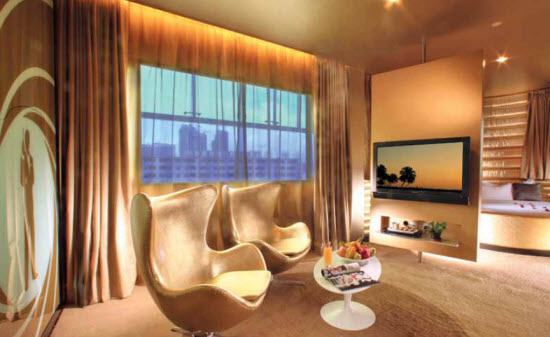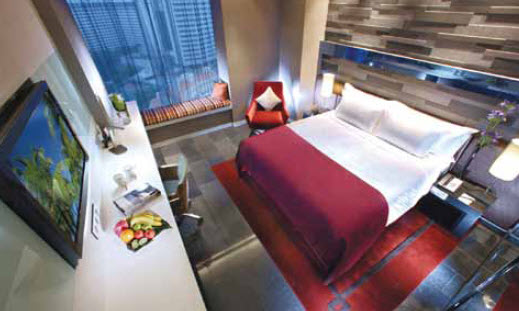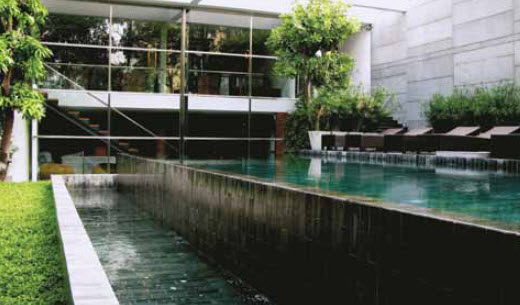The Inn Brand
Are the curtains falling on the world’s major hotel brands? Deborah Erwin peers behind the drapes to see how hospitality enterprises are designed for survival.
While hospitality behemoths are still adding to their global portfolios, independent boutique groups are also gaining ground in the market. Just as branding is fundamental to the survival of established heavy-hitters, it is vital for small emerging companies in the field to broadcast their identities clearly and hit their target audience. And like all other businesses that use branding as a publicity vehicle, the hospitality sector understands that identity formation goes way beyond fancy signage. Branding experts, hotel operators and designers alike agree that branding has become multi-dimensional and involves delivering a memorable experience.
The Branding Consultant View Brand consultancy firms, Brandimage and KEEN, work with new and established hotels to launch and fortify company identities and images. Just as the name ‘brandimage’ suggests brands and images are interrelated. With offices in North America, Europe and Asia, this company has advised a multitude of clients from various sectors including Air France, Club Med and Accor. Craig Briggs leads the charge in the Asia-Pacific region as Managing Director: “We provide full strategic design services to hospitality clients, which begins with brand positioning development, moves into conceptual design, design development, construction documents and construction supervision”.
Likewise, KEEN tags itself as “a brand strategy and integrated communications agency”. Helmed by CEO David Keen, the eponymously named company has worked for Amari Hotels & Resorts, Amantara Resorts & Spas, Accor Asia and several independent hospitality enterprises “from the conceptualisation of a new brand identity to strategising and executing the roll-out of a global brand into a new targeted market”.
|
|
| Hotel Re! in Singapore |
Laying the groundwork for a project involves studying the client brief and surveying market conditions. “We interpret the brief as we move into performing a strategic and visual audit of the market — their competition, market trends and consumer behaviour,” says Briggs. “In the case of a new hospitality or residential brand,” adds Keen, “this begins with the development of a complete brand culture in consultation with the project’s owners and key managers, as well as with architects, designers and operations staff to see that the brand is expressed through every detail”.
More than a Logo
Briggs emphasises that when a new hotel brand is birthed “it needs to be distinctive and respond to travellers’ needs in a unique way in terms of price, service, amenities, personality the contact between customer and brand exists through product, service and design — all touch the customer and form a sense of preference, or rejection.” Keen adds, “A brand is much more than a logo on a letterhead or signage on a façade. It encompasses what the brand means to its users — its customs, politics, language, design motifs — the culture of the brand”. As for hospitality giants, Keen warns: “The big brand is dead. The market demand now leans towards smaller, more precise, highly defined experiences that make a lasting impression. Creating such a brand is all about desire — creating desire, anticipating desire, sustaining desire, and ultimately, fulfilling that desire”. He explains, “Many hotels and resorts start out offering a great product, but fail because they have not built a strong culture of desire around that product”. David Ashen, Principal of D-Ash Design, a New York design firm that has successfully churned out hotels and restaurants across the globe, adds “Success can often be perilous as brands become tentative to make changes, and this is when brands begin to fail. It is when one is comfortable that one should probably think about how to make themselves uncomfortable again, and pursue innovation anew”. Long-standing and far-reaching hotel empires are challenged by its globe-trotting guests, says Keen, “Today’s travellers seek engaging, interactive experiences a number of established brands come to us asking how they can reposition themselves to appeal to these more experience-seeking travellers”. When communicating a brand, “design is a powerful and intimate form of contact with the customer,” says Briggs, “poor design is quickly forgotten, but great design is penetrating, memorable and plays a primary role is creating an emotional bond.” Keen agrees: “the scope of the brand includes what guests experience and perceive the moment they walk in the door of the brand’s physical spaces. For a hotel, resort or residence, this means the lobby, the room, the restaurants — all are incarnations of the brand and it is important that the designers of these spaces make sure that they reflect the spirit of the brand as well”.
|
|
| URBN Hotel in Shanghai. |
Avant Garde Hotel Operators
On the frontlines, or at the reception desks, of the hotel industry are the operators. Not only are they charged with ensuring optimal and consistent service for every one of their guests, they also need to walk the walk, talk the talk and generally embody the company’s brand. Bangkok’s LUXX opened three years ago as a comfortable and simple inn with a no-frills concept. General Manager, Dusadee Srishevachart, describes it as “a very premium design/boutique bed and breakfast”. It offers 13 rooms but no gym, pool or bar. Instead, one can expect ‘space, style and privacy’, as emphasised on the website. “We cover all the basic needs which are: good locations, clean room, and value for money.” This past June, LUXX XL added 51 rooms and suites to the company’s portfolio. As the name suggests, this outlet offers more bang for one’s buck, but within similar aesthetic and ambient bounds. LUXX XL features a pool, bar, restaurant and expansive garden. In terms of design, both hotels take cues from the serene, straight-lined and modern likes of Japanese design. Honey-hued wood panels and flooring are paired with white walls to create pristine yet cosy atmospheres throughout. “Our rooms are simple modern Zen. We also give extra space in [and] out of room[s],” says Srishevachart. “We aim for guests from any part of the world, with age range from 25-45, design/style conscious,” he adds. Branding is very design oriented, advertising a discreet and tranquil alternative to the highprofile and highly trafficked goliaths in the market.
|
|
| Hotel Quincy in Singapore. Photograph by Far East Organisation. |
Green & Chic
A mere two years old, URBN Hotels in Shanghai has made unprecedented waves in the market as one of China’s first boutique establishments. From day one, the owners bucked convention by opting to retrofit an abandoned prosthetic limb factory downtown instead of developing a new-build. Teaming up with architectural firm A00, the owners sought to do more than just reuse space, they sought to create a carbon-neutral hotel. And while its function and environmental responsibility were priorities, thoughtful design and decoration were also key. The result is an attractive package that flaunts 26 designer rooms. Despite its commendable operations which include energy-efficient cooling and heating systems, water-based air conditioning, heat recovery ventilators, low-emissivity paint and low-watt lighting, patrons come for the chic interiors and comfort — not because it’s carbon neutral and eco-conscious. “People come to the hotel for a luxurious experience, because it’s artfully designed for the special attention to details and individualised service,” says Victoria Hajjar, Marketing Manager at URBN Hotels. The company spent “very little money on advertising,” and instead invested in a website to reach international clients. Hajjar mentions that industry attention received through “awards ha[s] been very important.” As for keeping in touch with patrons, she notes it’s important to review customer satisfaction every few months. “I think it’s vital to pay attention to the reality of what’s going on in the hotel, and observe who’s coming into the hotel and why”. Feedback cards have a fifty percent response rate at URBN. Apparently most are positive and pertaining to the restaurant and level of service.
Retro-boutique
Singapore’s retro themed inn, Hotel Re! relies heavily on design to communicate its unique offering and brand. “A boutique hotel means out-of-the-ordinary design coupled with quality rooms and extraordinary service,” explains Jessica Loo, Marketing Manager at Hotel Re!. “When the concept for the hotel was created, the owners were looking for a bold design theme that would be easily recognisable.” Each of the 140 rooms is splashed with hot pink, gold or lime green. “Bright colours and silhouettes in all rooms coupled with retro furniture and splendid mosaictiled bathrooms embody the retro theme while touches of modern grey in the beddings and furnishings keep the rooms from being over the top,” adds Loo. “Hotel Re! tends to select channels like social and new media which allows more interaction with the consumers. We also select partners carefully for example, Hotel Re! is the only hotel in Singapore that is a partner of the Epoque Hotels group which specialises in representing independent boutique hotels all around the world.” In terms of brand revision and refinement, Loo notes that because it’s a boutique hotel and “so much of the brand hinges on the design,” frequent strategic review is unnecessary “unless there are plans for a complete face-lift and a change of theme.”
|
|
| LUXX XL in Bangkok. |
The Design Influence
When hired to design Hotel G in Beijing, Mark Lintott at Mark Lintott Design (MLD) understood that the 100-room building was to be custom-made for “open-minded, free travelling, fashion aware guests for people who are bored with formulaic design.” He set out to create “a comfortable night club that is dark, moody and uses deep and rich colours.” Instead of appealing to stuffy middle-aged corporates, this establishment seeks to attract “the late night crowd,” he adds, those who typically go for “drink meetings instead of boardroom meetings, those who eat well and drink well.” The night club concept is less about colours, textures and lighting, and more about “getting out of one’s skin and being challenged,” expands Lintott. In terms of branding during a hotel’s lifetime, he says “some of best hotels are not revamped every 5-7 years,” as is often prescribed for this sector. “The problem with branding is that it’s artificial and constantly trying to update and refresh. If you have a good product then you shouldn’t need to change it it should be timeless and shouldn’t have to be rammed down your throat”.
In contrast, Ariane Steinbeck, Principal Designer at Gettys, believes “it’s good to reinvigorate a brand every 5-8 years but not to dilute it.” She argues that “if you don’t keep up with technology then you will lose those customers to other hotels, this doesn’t mean that you need to redesign your whole room, but maybe just install the latest technology”. She also points to the importance to knowing one’s key market. “What is that particular customer looking for?” she poses. “Some are looking for lifestyle experiences, aspirational experiences.” For instance, an ordinary guest might want to feel like a powerful CEO or a middle-aged person might want to feel hip and edgy. To develop design concepts, “We use DNA – Differentiators, Nuances and Attributes,” adding that through verbal and visual workshops, her firm and the hotel group arrive at a list of words for feelings and business goals.
Drawing on past and present experience with heavy-hitters such as Shangri-La, Sheraton and Hilton, she adds “Brand standards from bigger hotel companies are very definitive when it comes to function but not so much with aesthetics. They are often modern with clean lines and very subtle”. While designers want to put their own stamp on a project, she emphasises the need to remain faithful to the “personality of a brand”.
Singaporean firm Ong&Ong understands the full-service approach, which they applied while working on Hotel Quincy in Singapore. Since the owners intended the project to be a jazzed-up extension of the existing Elizabeth Hotel, they flew the entire design team to Paris to study Christophe Pillet’s Hotel Sezz. The architecture firm devised a concept that was equally chic and cheeky. To thoroughly integrate the hotel’s central ideas, Ong&Ong adopted what it calls a ‘360 degree design solution’. This encompasses architecture, landscape design, environmental issues, branding, interiors plus graphic and web design. Therefore, the firm not only helped to shape the building inside and out, it also helped to create a logo and marketing strategy. With some brands failing, and other making their mark, ultimately branding is a feat to be accomplished and refined by hotel owners and operators (and their general managers who are in direct contact with patrons), branding experts (to keep abreast with macro trends and market demands) and forward-thinking hotel interior designers.



